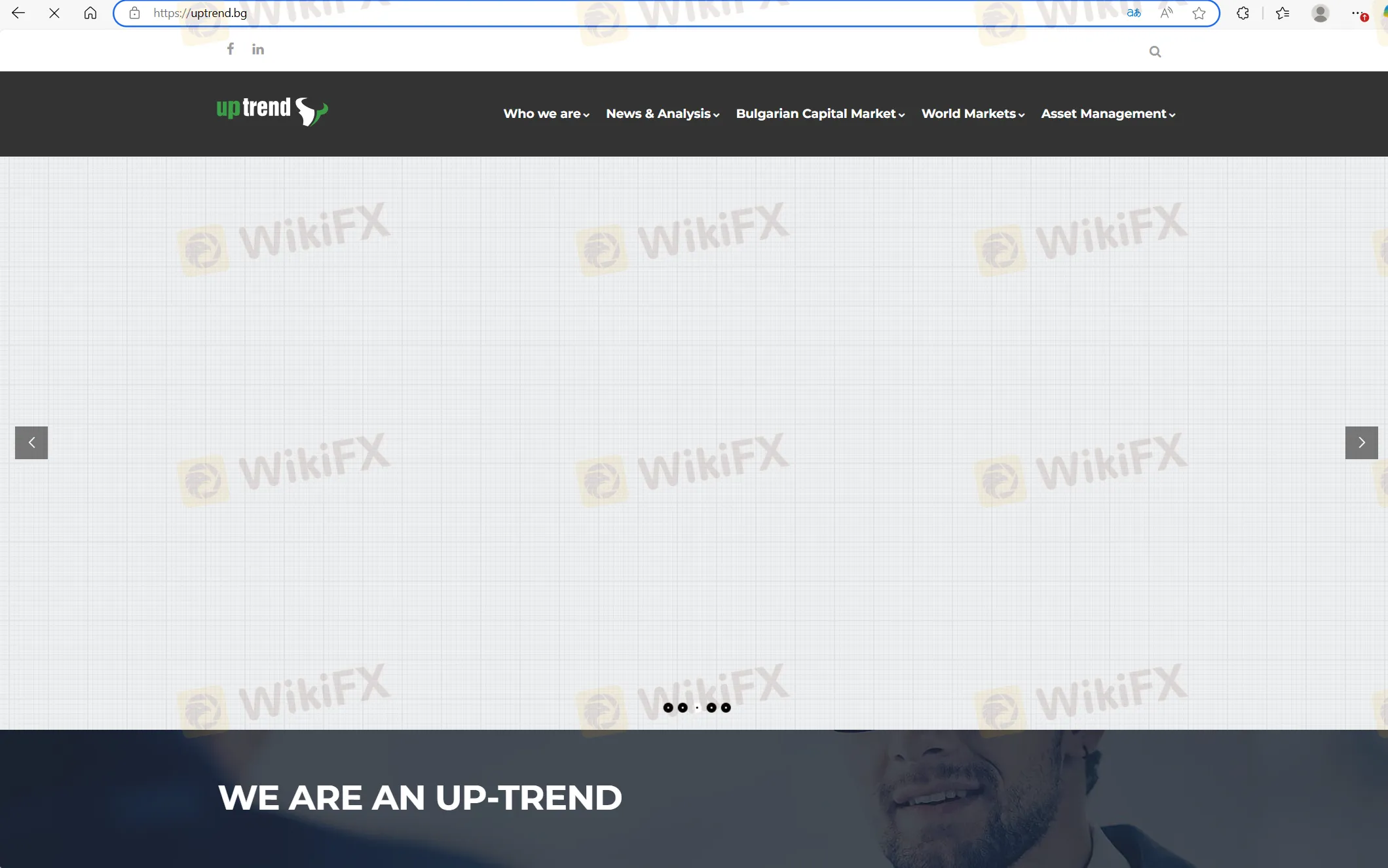기본 정보
 불가리아
불가리아
점수
 불가리아
|
5-10년
|
불가리아
|
5-10년
| http://uptrend.bg/
공식 사이트
평점 지수
MT4/5
전체 라이선스
UpTrend-mt4-demo.xtrade-dm.net

영향력
D
영향력 지수 NO.1
 불가리아 2.53
불가리아 2.53
MT4/5 감정
전체 라이선스
 독일
독일영향력
D
영향력 지수 NO.1
 불가리아 2.53
불가리아 2.53 라이선스
라이선스효력 있는 규제 정보가 없습니다. 위험에 유의해 주세요!
 불가리아
불가리아

정식 MT4/5 마스터 레이블 브로커는 건전한 시스템 서비스와 사후 기술 지원을 제공합니다. 보통 비즈니스와 기술이 성숙하고 리스크 관리 능력이 강합니다.
 uptrend.bg
uptrend.bg 터키
터키| UP TREND 리뷰 요약 | |
| 설립 연도 | 1997 |
| 등록 국가/지역 | 불가리아 |
| 규제 | 규제 없음 |
| 금융 서비스 | 자산 관리, 투자 자문, 중개 서비스, IPO/SPO 지원, 금융 상품 보호 등 |
| 고객 지원 | 전화: +359 2 815 56 60 |
| 이메일: uptrend@uptrend.bg | |
| 주소: 소피아 1407, 불가리아, 블루바드 니콜라 Y. 바프차로브 51A, 1층 | |
Up Trend은 1997년에 설립된 불가리아 최초의 라이선스 투자 중개업체 중 하나입니다. 1998년부터 불가리아 증권 거래소와 중앙 예탁소의 회원이었습니다. 이 회사는 EU 전역 라이선스를 보유하고 자산 관리, 투자 자문, 중개, IPO/SPO 지원 및 금융 상품 보호를 포함한 다양한 금융 서비스를 소매 및 기관 고객에게 제공합니다. 시장 분석을 발표하기 위해 톰슨 로이터스, 캐피털 아이큐, 블룸버그, 팩트셋과 파트너십을 맺고 있습니다. 본사는 불가리아 소피아에 위치해 있습니다.
그러나 현재 해당 브로커는 공식 당국에 의해 잘 규제되지 않고 있습니다, 이는 신뢰성과 신뢰성이 떨어질 수 있음을 의미하므로 주의가 필요합니다.

| 장점 | 단점 |
| 다양한 금융 서비스 | 규제 없음 |
| 수년간의 산업 경험 |
브로커리지 플랫폼의 안전성을 측정하는 가장 중요한 요소는 공식적으로 규제되었는지 여부입니다. UP TREND은 규제되지 않은 브로커로, 사용자 자금과 거래 활동의 안전이 효과적으로 보호되지 않습니다. 투자자는 UP TREND을 신중히 선택해야 합니다.

Up Trend Ltd.는 소매 및 기관 고객을 대상으로 다음과 같은 다양한 투자 서비스를 제공합니다:
그들은 다음에 액세스할 수 있는 중개 서비스를 제공합니다:
| 거래 상품 | 지원됨 |
| 주식 | ✔ |
| ETFs | ✔ |
| 채권 | ✔ |
| 외환 | ✔ |
| 상품 | ✔ |
| CFDs | ✔ |
| 지수 | ✔ |
| 파생 상품 | ✔ |
| 암호화폐 | ❌ |
| 옵션 | ❌ |



In my experience as a trader, the single most significant risk with UP TREND is its lack of verified regulatory oversight. Although there is mention of an EU-wide license and long-standing operation in Bulgaria since 1997, WikiFX highlights clearly that UP TREND is currently unregulated by recognized authorities. This means that, for me, any funds held with this broker would not benefit from protections typically offered by robust regulatory bodies—such as compensation schemes or clear recourse in cases of disputes or mismanagement. I’ve learned that regulation doesn’t just tick a box; it enforces standards that safeguard client assets and ensure broker integrity. When a broker operates without this layer of external accountability, both the security of my deposits and the transparency of how my trades are handled become much harder to verify. Even though UP TREND offers a full MT4 license and maintains established business partnerships, those technical or operational positives cannot substitute for strong, active regulation. Moreover, the “high potential risk” label and low independent review scores raise my personal caution further. If any issue arises, such as withdrawal delays or pricing disputes, my ability to resolve them could be severely limited. Therefore, while their range of services and experience might be appealing, for me, the absence of recognized regulatory protection is a critical drawback that cannot be ignored. I would advise approaching UP TREND with great caution and prioritizing brokers that provide transparent, recognized regulatory assurances.


From my personal experience and diligence as a forex trader, I found that UP TREND offers a maximum leverage of 1:100 for major forex pairs. Leverage is a double-edged sword in trading, enhancing both potential returns and risks. While 1:100 is generally considered relatively high—allowing traders to control larger positions with less capital—it demands careful risk management. For other asset categories on UP TREND, such as stocks, ETFs, bonds, and commodities, the available leverage decreases significantly, with options like 1:50, 1:33, 1:25, 1:10, and even as low as 1:1. This tiered approach is common in the industry, reflecting the varying volatility and liquidity profiles of different markets. For me, being able to adjust leverage is crucial, but I exercise extra caution, especially since UP TREND currently lacks official regulation. Without adequate regulatory oversight, the risks associated with high leverage and fund safety become more pronounced. In summary, while UP TREND’s leverage levels may cater to traders seeking flexibility, I always remind myself and others that elevated leverage must be treated conservatively and only used with robust risk controls.


As someone who has traded with various brokers over the years, I always consider a platform’s transparency around fees and trading costs before committing any funds. When I looked into UP TREND, I was cautious because clear details regarding their commission structure and spreads were not provided via their main channels or their summary materials. This presents a challenge from a risk management perspective, since ambiguity about costs can impact the net results of any trading strategy—especially for active traders like myself, where both commissions and spreads play a critical role. I did note that UP TREND offers a diverse range of assets, including forex, stocks, ETFs, bonds, commodities, and CFDs. In my experience, a broker’s fee schedule for such a variety can vary widely depending on the asset class, and reputable firms typically disclose clear outlines on commissions per trade, spread markups, and any potential hidden charges like inactivity fees, withdrawal costs, or custodial fees for certain assets. Given that UP TREND operates without a recognized regulatory body currently overseeing its activities, the lack of publicly accessible, detailed information on their trading fees raises concerns for me. In regulated environments, fee structures are typically scrutinized and must be fully disclosed to clients. Here, for both commission charges and spreads, prospective users are left to rely on direct inquiries or live testing to ascertain real costs—which is never ideal. For me, I always recommend proceeding extremely carefully in such cases, prioritizing transparency and regulatory safeguards above all. Without explicit information, it’s difficult to evaluate the true trading cost and make informed decisions about position sizing or strategy viability. I believe that, in matters involving real financial risk, having full clarity on all potential fees is essential for protecting oneself and trading responsibly.


In my experience with UP TREND, the areas of customer support and platform stability require a conservative approach due to several important factors highlighted during my due diligence process. One of my chief concerns stems from the broker’s lack of regulation. While UP TREND advertises a full MT4 license and an extended presence in the financial sector since 1997, the absence of oversight from any credible regulatory body introduces uncertainty—in practice, this often impacts both service reliability and the safeguarding of client interests. When interacting with their customer support, I found response times to be moderate, but I couldn’t disregard the risk associated with having no regulatory recourse if my issue escalated into a dispute. The communication channels were standard—email and phone—but lacking an independent ombudsman or regulator meant I had to place a higher trust in their internal processes, which isn’t ideal for me as risk management is always a top priority. Regarding the stability of their trading platform, UP TREND does use the widely respected MT4 infrastructure, which usually delivers robust execution speeds, and their technical integration seemed mature. However, during times of elevated market activity, I noticed occasional latency—ping times averaging between 171 and 203 milliseconds on their servers. While not disastrous, these can be significant if I’m pursuing strategies that depend on rapid order execution. For me, the peace of mind that comes with trading through a regulated broker with proven client protection mechanisms far outweighs the convenience or breadth of services that UP TREND may offer, especially when assessing core needs like stable platform access and dependable support.



입력해 주세요....